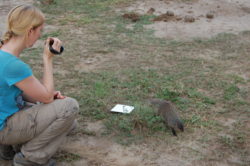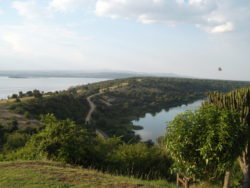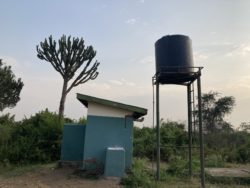Investigating the Impact of AMR on Wildlife
While CE4AMR’s work is focused on drivers of AMR within the health of humans and domesticated animals, one might ask the question “What is the place of wildlife in AMR?”. In this blog, CE4AMR Research Fellow, Jess Mitchell, talks about her recent trip to Uganda, where she investigated community perceptions of AMR drivers which could impact wildlife health. Let’s see what she’s got to say!

Over July 2022 I finally managed to return to my PhD field site in Queen Elizabeth National Park, Uganda. Amazingly it has been 6 years since I was last there dodging elephants and filming how banded mongooses react to each other’s anal glad secretions smeared onto floor tiles!
My PhD focused on scent communication in the Banded mongoose, bigger cousins of Meerkats who live in large social groups. Banded mongooses are quite choosey about who they mate with, likely because of the close relations within each group. I wanted to figure out how their sense of smell could influence their social behaviours, potentially explaining how mate choice happens. My PhD showed that mongooses respond differently to odours based on familiarity, biological sex, pregnancy status and parasite loads. This work also engaged me with the communities around the National Park and helped me understand the benefits and challenges they face due to living so close to wildlife. When I came to CE4AMR I really hoped that one day I could return to my former field site to work with communities and animals on the challenge of AMR.
 CE4AMR’s work is focused on community knowledge around AMR, which I find fascinating and imperative to understanding the wider challenges of drug resistant infections. However, CE4AMR projects currently focus on drivers of AMR within the health of humans and domesticated animals. As a zoologist I am really interested in the place of wildlife in AMR. This is a sparsely researched area but one where there is huge potential.
CE4AMR’s work is focused on community knowledge around AMR, which I find fascinating and imperative to understanding the wider challenges of drug resistant infections. However, CE4AMR projects currently focus on drivers of AMR within the health of humans and domesticated animals. As a zoologist I am really interested in the place of wildlife in AMR. This is a sparsely researched area but one where there is huge potential.
For example:
- (How) do trace antimicrobials reach wildlife and does this impact on the levels of resistant genes and microbes seen in wildlife species?
- Could resistant microbes in wild species lead to extinction events, biodiversity loss or even ecosystem collapse?
- (How) do other challenges impacting wildlife health such as climate change and biodiversity loss intersect with AMR?
- Can an understanding of AMR in wildlife help communities connect to the wider issue of AMR?

In 2021 I was awarded a small internal grant to pursue my own research interests and I immediately looked back to my PhD field site as a potential area to assess the role of wildlife within AMR. The trip this summer (2022) finally allowed me to reconnect with research teams, rangers, teachers, and community leaders to discuss their experiences of AMR and map the local AMR risk factors.
Firstly, I worked with my close contacts, banded mongoose researchers and teachers to understand what working knowledges of AMR there are in this area and what language is used in reference to antimicrobial pollutants, medicines and so on.
Secondly, I met with local Village Health Teams and community clinics to understand they types of antibiotics commonly used in human health, common (mis)use issues and the relationship between government funded and private health care centres.
Thirdly I joined the new lab team on the field site to consider the wider environmental challenges driving AMR in this area. We reflected on issues such as agro-pesticide usage, mining waste, sanitation issues and wild animal movement; all of which are influenced by rather extreme climatic changes this area is currently experiencing. We also discussed the lab capacity to analyse data relating to these factors.
One of the major outputs of this trip was a community co-created map identifying AMR risks in the area. There is a particular focus on the impact of AMR on wildlife, but human, domestic animals and environmental impacts are also considered.
The main points our community identified were:
- Good access to water but poor sanitation.

-
- An over-reliance on poorly maintained pit latrines which often overflow during the rainy seasons and a lack of handwashing stations by latrines/toileting sites. This was identified as a risk of infection.
- Close proximity of humans and domesticated animals in the homestead could spread infections.
- Wildlife foraging in crop fields, waste sites and generally coming into close contact with people and animals could spread infections.
- Run-off of heavy metal waste from mines in mountains and foothills was identified as a potential driver of AMR.
- Poaching injuries to both wildlife and rangers was identified as a potential infection risk and a driver of broad-spectrum antibiotic use in both the conservation and human health sectors.
- Village Health Teams (the base level of community health in the area) are trained to prescribe antibiotics but often have limited supplies or choices of drugs which can lead to misuse.
- Equally when VHTs refuse to prescribe antibiotics they can face push-back from the community.
- Community members who can afford to purchase antibiotics from drug stores will do so against the advice of the VHTs.
- Drug stores sell antimicrobials for human and animal health. Often the staff and owners will have no formal medical, pharmaceutical, or antimicrobial stewardship training. This was identified as potential driver of antibiotic misuse and AMR.
- Malaria is endemic in this area and there are high levels during the shoulder seasons when a lot of standing water is present.
- The community also highlighted the increasing numbers of tourists taking prophylaxis could be driving resistance to anti-malarial drugs.
- Veterinary and laboratory teams highlighted that due to climate change and longer dry periods the use of agri-pesticides in small holder farming is increasing.
- This could be a driver of AMR in the local and wider areas as when rains do come the pesticides are likely to run-off into the lakes and channels which then pass-through protected areas, human settlements, and other small holdings.
- The area is close the boarder with DRC. During periods of conflict both people and wildlife cross the lake to reach Uganda. The community suggested this could allow infections, including resistant infections to move with them.
My job now is to develop these preliminary findings into grant and fellowship applications with a view to placing wildlife at the heart of One Health research on AMR. Watch this space!
